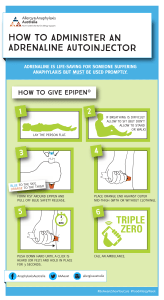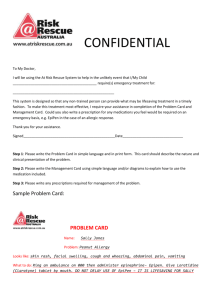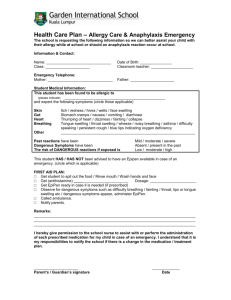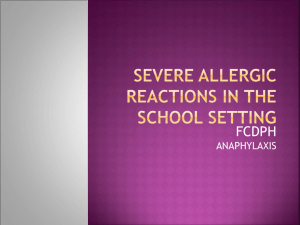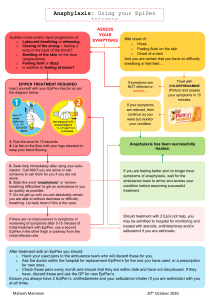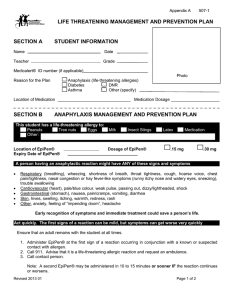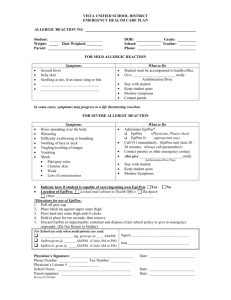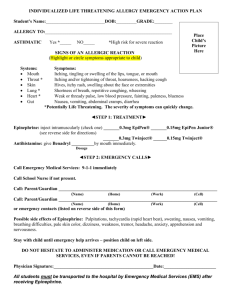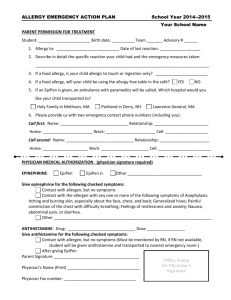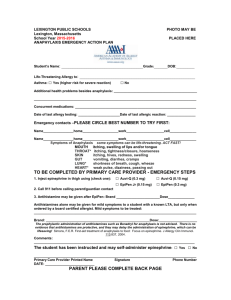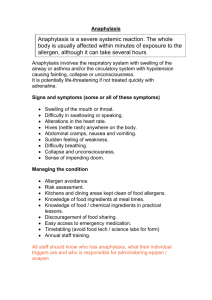Anaphylaxis Treatment Plan WORD
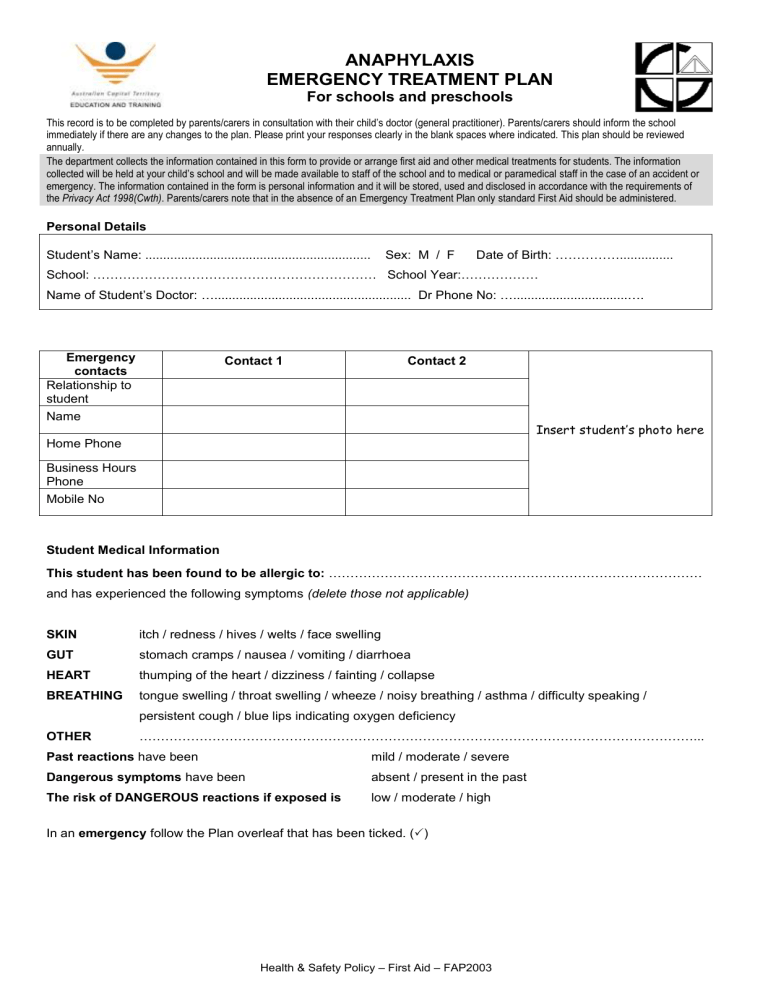
ANAPHYLAXIS
EMERGENCY TREATMENT PLAN
For schools and preschools
This record is to be completed by parents/carers in consultation with their child’s doctor (general practitioner). Parents/carers should inform the school immediately if there are any changes to the plan. Please print your responses clearly in the blank spaces where indicated. This plan should be reviewed annually.
The department collects the information contained in this form to provide or arrange first aid and other medical treatments for students. The information collected will be held at your child’s school and will be made available to staff of the school and to medical or paramedical staff in the case of an accident or emergency. The information contained in the form is personal information and it will be stored, used and disclosed in accordance with the requirements of the Privacy Act 1998(Cwth). Parents/carers note that in the absence of an Emergency Treatment Plan only standard First Aid should be administered.
Personal Details
Stu dent’s Name: ............................................................... Sex: M / F Date of Birth: ……………...............
School: ………………………………………………………… School Year:………………
Name of Student’s Doctor: …....................................................... Dr Phone No: …................................….
Emergency contacts
Relationship to student
Name
Contact 1 Contact 2
Insert student’s photo here
Home Phone
Business Hours
Phone
Mobile No
Student Medical Information
This student has been found to be allergic to: …………………………………………………………………………… and has experienced the following symptoms (delete those not applicable)
SKIN
GUT itch / redness / hives / welts / face swelling stomach cramps / nausea / vomiting / diarrhoea
HEART thumping of the heart / dizziness / fainting / collapse
BREATHING tongue swelling / throat swelling / wheeze / noisy breathing / asthma / difficulty speaking /
OTHER persistent cough / blue lips indicating oxygen deficiency
…………………………………………………………………………………………………………………...
Past reactions have been
Dangerous symptoms have been
The risk of DANGEROUS reactions if exposed is mild / moderate / severe absent / present in the past low / moderate / high
In an emergency follow the Plan overleaf that has been ticked. ( )
Health & Safety Policy – First Aid – FAP2003
STANDARD FIRST AID PLAN
If exposure is suspected:
Where EpiPen is stored: ……………………………………………………………………………………………………….
Call for help (eg. Other staff, ambulance)
Get student to spit out the food
Rinse mouth
Wash hands and face
Get EpiPen ready in case it is needed
Give ………………………………………… of ………………………………………………….. (antihistamine) Y / N
Observe for dangerous symptoms such as difficulty speaking/breathing, gasping, collapse, fainting and throat/lips/tongue swelling.
If dangerous symptoms appear, administer EpiPen into mid thigh and double check that ambulance was called. Note TIME that EpiPen was given …………………………………………. am/pm
Notify Parents: Telephone: …………………………………………..
OR
My Child’s Anaphylaxis Emergency Treatment Plan (attached)
This student HAS /HAS NOT been advised to have adrenaline available in case of an emergency
USING EPIPEN
Remove grey cap
Hold in fist grip (do not touch either end)
Press black end of device into the front of the mid-thigh
Listen for a “click” as the device is triggered
Hold in place for 10 seconds
Remove EpiPen – be careful not to touch needle
Place in sharps container & hand to ambulance officer
I verify that I have read the preferred Anaphylaxis Emergency Treatment Plan and agree with its implementation.
Signature of Doctor: ………………………………………….Date:………………………..Date of Plan:…………………...
Signature of Parent/Carer:…………………………………….. Date:…………………………..
NOTES: Have a copy of Action Plan kept WITH the EpiPen. That way it can be followed by the person giving First
Aid, the steps can be ‘ticked off’ as they are done, and the used EpiPen and health information about the student and parent contact details can be given to the ambulance officers when they arrive. As exercise can make reactions worse, it is better to either carry the student closer to help OR bring adrenaline to the student. A sharps container is safer than putting EpiPen into a glass jar. Small sharps containers can be bought from Totalcare (ACT).
1) I / We (Parent/Carer) ……………………………………………………………… give permission for my/our child (name): ………………………………………………………………………..
a) to be treated in an emergency by staff at the school at the school using the preferred Anaphylaxis
Emergency Treatment Plan (including the use of adrenaline) if in their judgement it is required for the treatment of an allergic reaction. b) to be identified by a Student Medical Alert poster including a photograph of my child and personal information which is to be displayed in the school’s first aid and medical treatment room/s, staff room/s and other locations as considered necessary. These locations will be discussed with the parents/carers prior to action.
2) As a parent/carer I will notify the school in writing if there are any changes to these instructions.
Signed …………………………………………………………………………………… Dated:…………………………
Health & Safety Policy – First Aid – FAP2003
